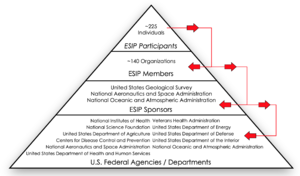Category:Identifying ESIP Connections
Identifying ESIP Connections
The ESIP community includes many organizations and people from all over the world and community members contribute to our understanding of Earth Systems and information systems in many ways. Connecting those contributions creates an interconnected web of organizations, people, data, software, wiki pages, blogs, papers and books that increases community knowledge and wisdom. Those connections rely on persistent identifiers to activate that web. The Identifying ESIP Connections project was started during the summer of 2019 with sessions on FAIR Metadata and Metadata Evaluation. These sessions included robust discussions of many aspects of metadata including many kinds of identifiers. One particularly interesting topic was organizational identifiers and, particularly, the recently released Research Organization Registry.
A Funding Friday project was proposed (see Figure) to help facilitate ESIP navigation of the growing identifier landscape. Pages that are relevant to this effort, many created as part of the Linking ESIP Project, are collected here. Hopefully they provide interesting and helpful information. Of course the community is invited to help these pages stay up-to-date by contributing information uncovered as we move forward.
The Research Organization Registry (ROR)
The Research Organization Registry is a community-led project that aims to develop an open, sustainable, usable, and unique identifier for every research organization in the world. It is supported by several large identifier infrastructure operators (CrossRef and DataCite) as well as the University of California systemwide California Digital Library and recently released the first version of a registry based on GRIDs donated to the effort by Digital Science. Until the ROR community takes over curation and management of the Registry, the contents will continue to be the GRID data. The GRID database is updated several times a year according to open policies, and is publicly available at no cost and dumps of the ROR data are also available.
Adopting RORs
Creating change in large organizations is a difficult process that depends on organizational capabilities and leadership. Adopting a new identifier is hard, just like any other change process. Consider, for example, ORCIDs. Everyone in ESIP has heard of ORCIDs and most ESIP participants have ORCIDs, but they are only included in less than 10% of current Crossref journal article metadata. To be effective, adoption must start with a small number of secret change agents that are already doing the right thing, i.e. the kind of people that gravitate to ESIP.
The goal of Identifying ESIP Connections is to help empower those change agents by enabling them to 1) start using organization identifiers and 2) provide information that others in their organizations need to get started. We are starting by exploring identifiers from the Research Organization Registry at four levels: US Federal Agencies, ESIP Sponsors, ESIP Membership, and ESIP Participants. The Figure shows a schematic illustration of how ESIP participants, members, and sponsors can influence others to facilitate the adoption of RORs.
US Federal RORs - Finding RORs for all U.S. Federal Agencies turns out to be a bit of work. A preliminary list and a description of how it was found can help researchers that work in or are supported by U.S. Federal agencies start.
ESIP Sponsors - ESIP has three Type IV Federal Sponsors: National Aeronautics and Space Administration (NASA), National Oceanic and Atmospheric Administration (NOAA), and United States Geological Survey (USGS). These agencies recognize that ESIP brings together many leading informatics experts to share experience, expertise, and ideas for future directions. RORs exist for many offices within these organizations.
ESIP Members - Many ESIP members have RORs.
ESIP Participants - Participants in ESIP provide information about the organizations they are affiliated with when they register. Many of these organizations have RORs.
Pages in category "Identifying ESIP Connections"
The following 5 pages are in this category, out of 5 total.

